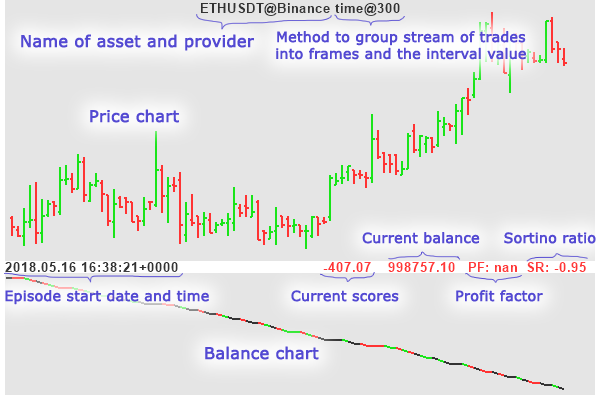Intraday Project Explained
I created a package which provides gym compatible environment to simulate intraday trading based on stream of trades, either historical or real-time.

This project was inspired by TensorTrade, but it was written from scratch, and it is a completely original source code.
The main idea was to go deeper from candles to the actual stream of trades. Because candles lose a lot of information, for example:
- How many trades during a period were initiated by buyers or by sellers?
- At what price did most of the trades happen during a period?
- At what price there were almost no activity?
- Were there many trades with small amounts or less trades with big amounts?
- etc.
Here is some explanation of different values on this screen:

By the way, notice different colors on the balance line? Each color describes a position agent was at that moment:
- Green: agent was in long position.
- Red: agent was in short position.
- Black: agent was not in position.
Details
This project tries to simulate trading environment as realistically as possible. A lot of trained models seem to perform good during training, but often fail to show any positive result in real trading. Mainly because they ignore following issues.
Order delays from agent to exchange
There is always a delay between the moment agent makes its decision and the
moment order reaches an exchange, due to network or exchange delays.
Typically, about 1..3 seconds.
This package allows you to specify it explicitly in agent_order_delay argument.
Order delays from broker to exchange or inside exchange
For some kind of orders like: TakeProfitOrder or StopOrder there is a small internal delay
between the moment broker/exchange server decides to execute this order by placing the MarketOrder
and the moment when MarketOrder reaches an exchange. Typically, about 0.5…1 seconds.
This package allows you to specify it explicitly in broker_order_delay argument.
Realistic bid-ask spread
When agent wants to buy or sell immediately it issues a MarketOrder.
This order should be executed by the best price which is available there in the order book.
But there is always a gap between best bid and best ask price, which is often ignored.
Imagine a situation: the last trade was a sell at a price 103.5,
and agent decides it should buy immediately.
But it can’t buy at this price, since it was a sell trade, which was executed at the best bid price.
While buy order will be executed at best ask price.
The best ask price is typically higher than best bid price, say, for example: 104.0 (thus the spread is: 0.5)
We don’t have order book since this is a simulated Exchange environment. But this package analyzes the stream of buy and sell trades and estimates the mean and std values for the bid-ask spread. It then uses the upper estimation of spread to choose the realistic price for MarketOrder to be executed.
Limit orders realistic execution
Another issue is with limit orders. Sometimes limit orders are not executed even if price touches them.
Simply because they were last in the order book and there were not enough corresponding market buy(sell)
orders to fulfill them.
This package lets you specify explicitly the probability for limit order to be executed in such scenario,
via order_luck argument.
Support for multiple agents
Unlike most gym environments this package is able to run multiple agents on the same episode.
It does this by allocating different virtual broker’s accounts for each agent.
So each agent has its own initial_balance and can perform its own trades.
This can be useful for some optimization algorithms like: Evolutions Strategies, CMA-ES, etc.
Support for idle penalty
When trained in complicated stochastic environments agents often tend to do nothing. This is a simple way to save its life or money balance. A simple solution to the problem is to introduce some penalty for agent for being idle.
Thus, its balance will slightly decrease on each step even if it did not open long or short position.
This decrease is equal to the price range of the current frame multiplied by idle_penalty parameter.
Liquidation of agent account when it goes bankrupt
In reality, in most cases, exchange will block your account if your balance becomes negative. This means you can no longer buy or sell assets.
Maybe this is not very useful for the aim of agent training. I suggest a better approach would be to let it make mistakes at the beginning of learning. And after some time, as it matures, bring some real constraints.
This could easily be achieved by specifying very large initial_balance at the start of training.
And then reduce it to some realistic value over time.
Adjustable commissions
Many researchers successfully train their models to trade different assets without commission. Then, of course, these models fail in the real world. Because if there are no commissions in training environments agents may learn to perform a lot of trades. Which will lead to a great losses in the real world.
This package allows you to specify either a fixed commission, or a callback function. For example:
def binance_commission(operation: str, amount: float, price: float) -> float:
return 0.0004 * abs(amount) * price
Note: operation in a string, one of: {'B', 'S'}
Support for any kind of data providers
BinanceArchiveProvider - automatically downloads monthly trades archives from binance.com
and converts them into .feather file format for faster loading.
All you need to do is to specify symbol name, for example: ‘BTCUSDT’, and dates range.
BinanceKLines - automatically downloads monthly candles archives from binance.com
and also converts them into .feather file format for faster loading.
KLine is a binance candle with some additional fields.
If you want to investigate large time intervals: say 30 minutes or 1 hour - processing trades archives
becomes too slow. In this case you may want to use 1 minute klines as your data source.
Note, that in this case you should not rely on features which analyze trades,
because trades are simulated in case of klines or candles.
MoexArchiveProvider - provider which works with raw stream of trades from Moscow Exchange
saved in a special binary format: *.trades.gz.
In this format each file represents one trading session (one day).
Just ignore it if you don’t access to these archives.
SineProvider - Sine wave generator with adjustable noise. If you want to train a trading bot, this sine generator would be a good test for it. If your algorithm fails to learn to make profit even on such simple data, it will never find any profit in a real market data.
For more details:
